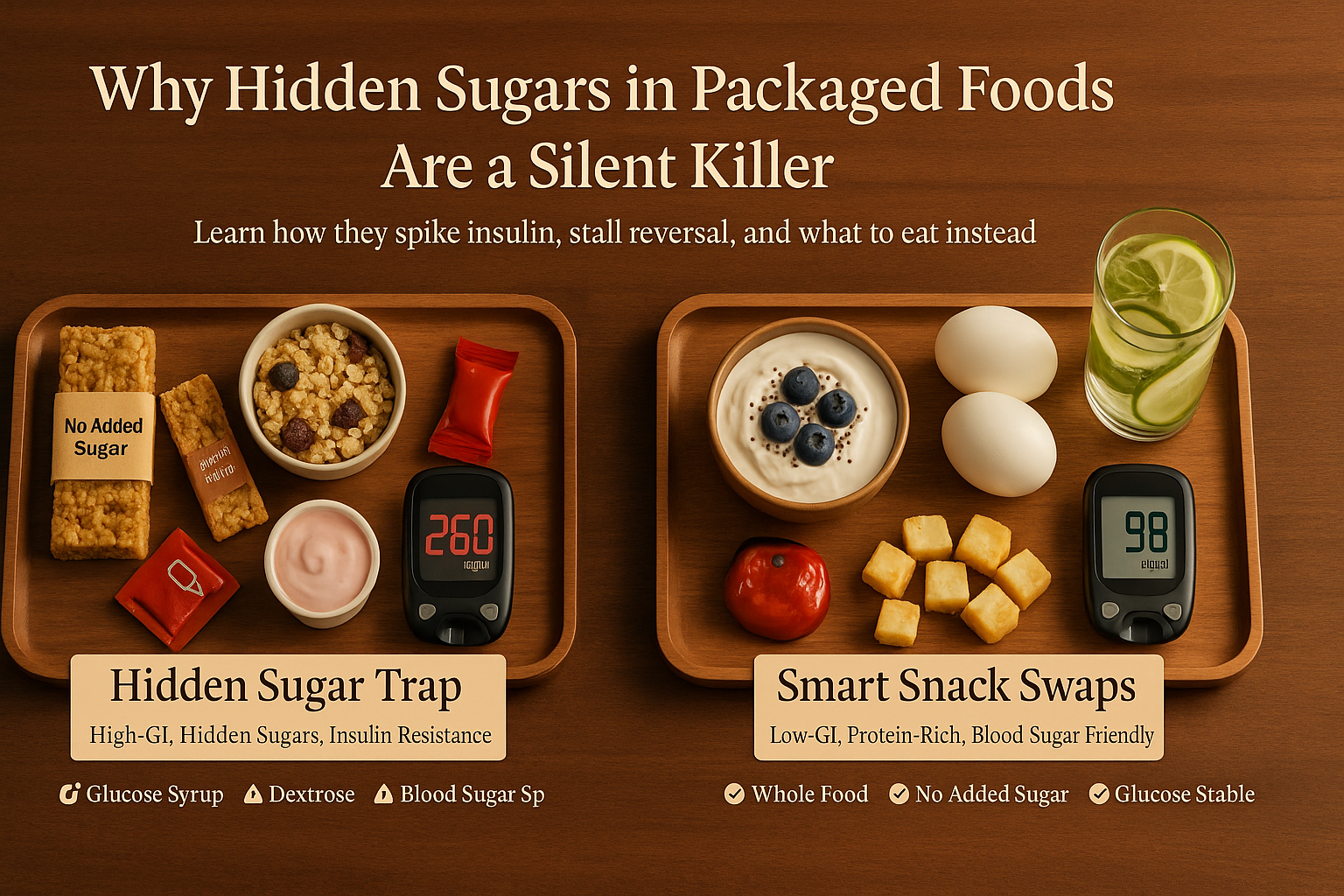Author’s Introduction
Hi, I’m Mansi Bhatt, Clinical Nutritionist at Redial Clinic, Green Park, Delhi. I hold an M.Sc. in Food & Nutrition from Lady Irwin College (DU) and specialise in reversing type 2 diabetes, obesity, and metabolic disorders through low-carb, high-protein, and healthy fat-based diets. Today, let’s uncover why hidden sugars in packaged foods are silently harming your blood sugar, liver, and overall health.
What Are Hidden Sugars and Why Are They Dangerous?
Understanding “Added Sugars” vs Natural Sugars
Most people think sugar only means sweets or table sugar. But hidden sugars in packaged foods extend to anything added during manufacturing. Natural sugars are inherently present in fruits (fructose), vegetables, and dairy (lactose). Added sugar in snacks includes table sugar, high fructose corn syrup, maltodextrin, dextrose, rice syrup, and similar ingredients used to enhance taste, texture, and shelf life.
Even “natural” sweeteners like honey, jaggery, coconut sugar, or date syrup act like added sugar in your body, spiking blood sugar and insulin.
How Sugar Gets Hidden in Labels
Food companies use over 50 names for sugar to trick consumers. Examples include:
- Maltose
- Glucose syrup solids
- Agave nectar
- Fruit juice concentrate
- Rice syrup
- Corn syrup solids
They split sugar types on labels to keep each amount low, hiding the true sugar load – a classic food labels sugar traps strategy. For example, a granola bar might list oats, honey, brown rice syrup, cane sugar, molasses, and dates – each sounds harmless, but combined they form a sugar bomb.
Sugar’s Cumulative Effect
Even small hidden sugars in packaged foods throughout the day add up. Your breakfast cereal (10g sugar), protein bar (8g), flavoured yogurt (12g), salad dressing (4g), and ketchup (5g) can cross 30–50g of hidden sugars daily. The WHO recommends less than 25g added sugar per day for health. Imagine the damage when hidden sugar is in everything you eat.
Hidden sugar is not only in sweet snacks but also in so-called sugar in healthy snacks like protein bars and energy drinks, misleading diabetics and health-conscious people into thinking they’re making smart choices.
The Impact of Hidden Sugars in Packaged Foods on Your Health
Insulin Resistance and Blood Sugar Spikes
Consuming hidden sugars in packaged foods spikes blood glucose. Your pancreas releases insulin repeatedly to handle these spikes, eventually causing insulin resistance – the core of type 2 diabetes. Research confirms that high added sugar intake worsens sugar and insulin resistance, impairing your body’s ability to utilise glucose efficiently.
Repeated sugar spikes overwhelm your pancreas, leading to constant high insulin levels and poor cellular glucose uptake, worsening how sugar affects blood sugar control.
Fatty Liver, Obesity & Chronic Inflammation
Excess sugar converts to fat in the liver, leading to:
- Non-alcoholic fatty liver disease (NAFLD)
- High triglycerides and LDL cholesterol
- Belly fat accumulation
- Chronic low-grade inflammation
All these conditions increase the risk of metabolic syndrome and cardiovascular disease. Hidden sugars in packaged foods contribute significantly to these chronic lifestyle diseases.
Triggers for Type 2 Diabetes and Heart Disease
Long-term intake of hidden sugars in packaged foods damages blood vessels, increases oxidative stress, and fuels silent inflammation, leading to type 2 diabetes, hypertension, and heart disease.
Energy Crashes, Brain Fog & Sugar Addiction
Hidden sugars cause rapid blood sugar rise and fall, leading to:
- Midday energy crashes
- Poor focus and brain fog
- Cravings for more sugar, creating a vicious addictive cycle
Studies show sugar activates dopamine pathways like addictive substances, making withdrawal challenging. It’s no surprise many patients struggle to reverse diabetes by removing sugar, but it is entirely possible with proper guidance.
Common Packaged Foods Loaded with Hidden Sugar
Breakfast Cereals, Protein Bars & Granola
Even “high fibre” cereals and healthy-looking granolas contain high added sugar in snacks. One serving of flavoured granola may have 15–20g sugar, equal to a dessert. They’re classic food labels sugar traps disguised as health foods and are prime examples of hidden sugars in packaged foods that harm diabetics.
Flavoured Yogurt, Juices & Smoothies
Flavoured yogurts, bottled smoothies, and tetra pack juices labelled “no added sugar” still use concentrates or “natural” syrups adding up to 20–30g sugar per serving.
Ketchup, Salad Dressings, Sauces
Two tablespoons of ketchup can contain up to 5g sugar. Ready pasta sauces, mayonnaise blends, and salad dressings often hide sugars or maltodextrin to enhance taste and thickness.
“Healthy” Biscuits, Multigrain Snacks, Energy Drinks
“High fibre” or “sugar-free” biscuits often use sugar alcohols like maltitol or hidden sugars like rice syrup. Multigrain or protein bars marketed for fitness are prime examples of sugar in healthy snacks, containing syrups and concentrates, making them no better than candy bars. Many patients unknowingly consume these hidden sugars in packaged foods daily, worsening their insulin resistance.
How to Cut Hidden Sugar from Your Diet (Without Feeling Deprived)
Check Nutrition Labels — Total Sugar vs Added Sugar
Always check:
- Total sugar: Includes natural and added sugars
- Added sugar: Should ideally be 0–2g per serving
Ingredients are listed by weight. If any sugar type is among the first three, it’s best avoided.
Choose Whole, Unprocessed Alternatives
Replace processed snacks with:
- Boiled eggs or paneer cubes instead of protein bars
- Unsweetened Greek yogurt with chia seeds instead of flavoured yogurt
- Tofu sprouts salad instead of packaged cereals
Make Your Own Snacks
Homemade snacks are safer. Try roasted paneer in desi ghee or homemade coconut-almond laddoos without sweeteners for low sugar packaged food alternatives. Removing hidden sugars in packaged foods from your diet is a key step towards reversal.
Sweeten Naturally
If needed, use stevia. But the ultimate goal is to train your taste buds to enjoy unsweetened food, which is crucial to reverse diabetes by removing sugar and heal sugar and insulin resistance permanently.
How Redial Clinic Helps You Break the Hidden Sugar Cycle
At Redial Clinic, we empower patients to:
- Identify hidden sugars in packaged foods
- Read labels intelligently
- Build sustainable low-sugar meal plans
Our Diabetes Reversal Treatment focuses on:
✅ Low-carb, high-protein meals
✅ Healthy fats to heal insulin resistance
✅ Avoiding sugar in healthy snacks marketed as guilt-free
Through personalised counselling, you will deeply understand how sugar affects blood sugar and how to break free from sugar addiction permanently.
Conclusion
Hidden sugars in packaged foods are indeed a silent killer. They damage your liver, spike insulin resistance, and promote addiction while you remain unaware. Awareness is the first step:
✅ Check labels for hidden sugars
✅ Choose whole, unprocessed foods
✅ Make simple snacks at home
Your health is not destroyed by a spoon of visible sugar, but by invisible sugar creeping into every packaged meal. Removing hidden sugars is a powerful step to reverse diabetes, protect your liver, and restore energy.
FAQs
Q1. What’s the difference between added sugar and natural sugar?
Natural sugars occur in fruits and dairy, while added sugars are incorporated during processing (e.g. syrups, table sugar), raising blood sugar faster.
Q2. Can “sugar-free” foods still affect blood sugar?
Yes. Sugar-free foods often contain sugar alcohols like maltitol or high GI bulking agents that can spike blood sugar and cause gastric distress.
Q3. Are all packaged foods bad for diabetics?
Yes, most contain hidden sugars, starches, or unhealthy additives. Always check labels for total and added sugars.
Q4. How do I avoid sugar if it’s in everything?
Prioritise whole foods, learn to read ingredient lists, and prepare snacks at home for better control.
Q5. Will removing hidden sugars help reverse diabetes?
Yes. Eliminating hidden sugars reduces insulin resistance, stabilises blood sugar, and is crucial for Diabetes Reversal Treatment.
Final Verdict
At Redial Clinic, we have seen hundreds of patients reverse type 2 diabetes simply by removing hidden sugars in packaged foods from their diet. Don’t let packaged food marketing destroy your health silently. Book your personalised consultation today at Redial Clinic, Green Park, Delhi to build a sugar-free, life-restoring meal plan tailored to your health goals.






